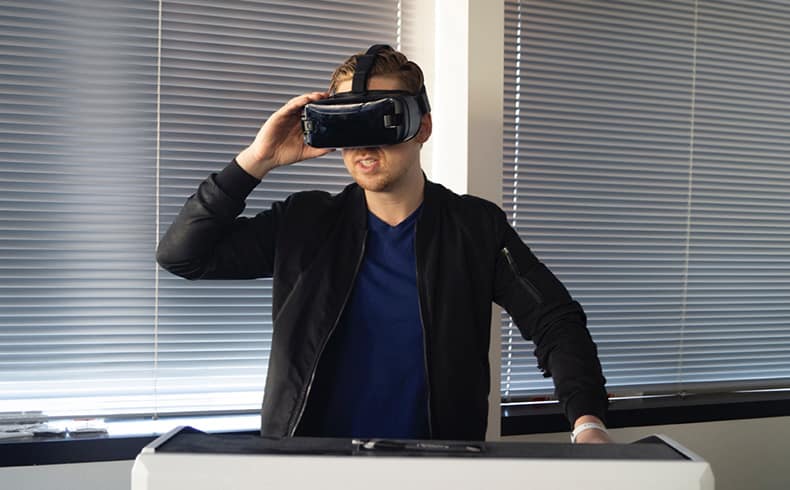Virtual Reality (VR) provides an virtual immersive environment detached from the real world around them. This allows objects in this environment to be simulated in a fabricated world. These headsets usually block off the view of the real world in a HMD (head mounted display) and can be standalone like the Oculus Quest 2 or tethered like the Valve Index headset. Science fiction provided us with a view of VR long before the technology was technologically feasible by showing us the Holodeck from Star Trek. Typically VR headset come with handheld controllers for interaction and can provide more tactile/haptic feedback to the end user.
Augmented reality (AR) provides an digital overlay to the real world to provide more contextual information to the user of the headset/device. This overlay provides additional information regarding the context of the environment. The user while in AR can visually see digital objects and text fields in their field of view. Some popular uses of AR today are used in hit games like Pokemon GO as well as furniture placement applications like IKEA’s virtual item visualiser. The major headset in the commercial space is the Hololens 2 of which we have several in our MRLAB. Additionally in the consumer space ARkit and ARCore are the leading technologies and we can offer several devices capable of running this technology from Samsung tablets to the latest Apple IPad pro variants containing the latest sensors for AR such as LIDAR.
Augmented Reality (AR) and Virtual Reality (VR) both refer to interactive digital experiences. In recent years, the costs of utilizing these technologies have come down considerably, in the case of the AR the consumer market has been quicker to adapt as most modern smartphones can run AR. This allows for low cost development of the AR technologies. This technology allows for the augmented data layer to display more, gives the user the ability to do more, and operate safely while seeing their environment and be more productive.
Whilst AR/VR have existed for several years dating back decades, the technology is now at a crucial adoption phase as the barriers to entry to the technology have significantly dropped. From a development point of view, the costs involved are dynamic, based on the size and scope of the project.
Stages of AR/VR
AR/VR development follow a familiar standard of software development with subtle differences.
1) Requirements
The requirements phase gathers all the necessary information for the project such as scoping, gathering of key early data, user requirements, system requirements, and more importantly for this type of development the necessity of it to be in either AR/VR or if relevant at all.
2) Design
The design phase involves the scoping of the software modules/platform as well as the design of the UI/UX which is a crucial to making a useful AR/VR application. The UI/UX can be tweaked and modified to the users liking in this phase as this will be the main method of interaction with the application and must suit the application parameters and functionality.
3) Implementation
Depending on the earlier steps the development can use several technologies in its implementation. For example if the application is a virtual reality application for training we would utilise the appropriate headset such as an all in one Oculus quest 2, the Oculus SDK, plugin libraries and the Unreal game engine.
4) Testing
Testing within AR/VR is very client focused as using a 3DUI/UX can be quite difficult for those unfamiliar and adoption of the design principles from the design phase is key in this section. Testing phase will eliminate any remaining bugs as well as help determine if the application meets the criteria set out in our requirements. Testing in AR/VR involves physical user testing with physical headsets.
FAQ’s
Can I get hurt in VR?
Nothing contained within the virtual world can hurt you, it is however important that you remain mindful of the real world environment you are in, as accidents can happen, and a user may bump into real world objects . The oculus quest does however have a system in place to prevent this from happening as it operates within a predefine boundary. The user will be alerted by the software if they move beyond the predefined area.
Does it cause motion sickness?
Virtual reality can cause motion sickness in some of its users however it is often person dependant. The developers have tried to circumvent this issue with the addition of teleportation as a means of movement, this method is known to reduce the likelihood of motion sickness. While VR may cause motion sickness in some, it is improving with each iteration of the technology.
Do I need a high-end PC to run it?
Yes and no, this will depend on what type hardware you use for the experience. Previous iterations of virtual reality hardware would require the use of a high-end PC but with the release of the oculus quest it has become less important as it can run in just the headset alone. For development and developers of VR applications it is desirable to have a high-end PC to meet all the demands of producing applications.
Is it just for games?
No. While most of the experiences offered to the public do come in entertainment form, it is becoming increasingly important in other areas such as virtual training and manufacturing. The possibilities of how virtual reality can be implemented has few boundaries.
